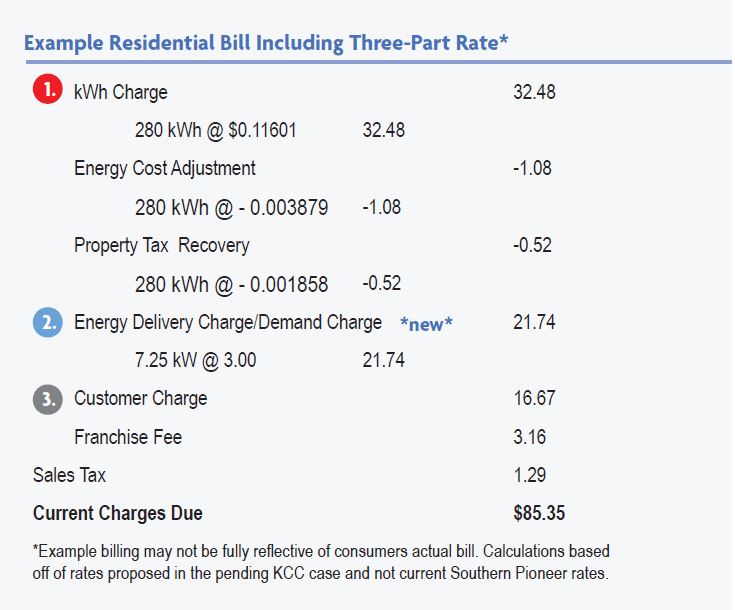After reviewing the current rate schedules for service to residential, commercial, and industrial customers, Southern Pioneer Electric Company (Southern Pioneer) has received an approved order from the Kansas Corporation Commission (KCC) for changes to its rate schedules. This includes the introduction of a three-part rate for all rate classes. The approved redesign will be effective on Aug. 1, 2024, and will be reflected on Customers’ bills beginning in Sept. 2024. Southern Pioneer has mailed a notice to consumers outlining the changes; these notices are also viewable through the links below.
What is a three-part rate?
The three-part rate separates the CUSTOMER CHARGE (a set charge for providing service), ENERGY DELIVERY CHARGE/DEMAND (kW) CHARGE (the rate at which a customer uses electricity) and ENERGY (kWh) CHARGES (cost per kWh of the total electricity used) assigned to a customer’s energy service. Transitioning to this three-part rate structure is intended to establish a more accurate representation of the individual customer class costs of providing energy service and to keep customers with lower demand from helping offset the cost of those with higher demand.
Identifying the three-part rate on bills
1. Energy (kWh) Charge: This is the cost per kWh of the total electricity used. With the separation of the Energy Charge and Demand Charges, consumers will see a reduction in this charge due to the separation of demand into its line item.
2. Energy Delivery Charge/Demand Charge (kW) *New*: This is a charge that allocates the costs to maintain power lines and upgrade the electrical infrastructure necessary to ensure customers have access to the power they need when they need it. This charge will vary each month based on the customer’s peak demand (kW) used within the billing cycle. Energy delivery and demand costs were previously included in the Energy Charge. Demand is set at one single point in the month depending on the customer’s energy consumption and will vary month-to-month.
3. Customer Charge: This is a set charge that does not change monthly. This charge helps cover some of the administrative and infrastructure costs incurred to provide service to consumers no matter how much electricity the customer uses.
What is demand?
Demand is the rate at which a person uses electricity. Demand increases when many large or power-hungry appliances operate simultaneously. In these instances, Southern Pioneer must have the infrastructure to ensure enough power is available to the customer’s home or business to satisfy their current need for immediate electricity. Southern Pioneer’s system must be built to supply energy at maximum demand for each customer. It is important to remember that demand is not the total amount of energy used;
it is the rate at which it is being used.
What can Customers do to manage their demand?
The energy needs of customers are not the same. The three-part rate is a transparent look at customers’ costs and allows them to see the direct impact of their energy habits. For some, convenience may outweigh the desire to reduce demand. However, those looking to reduce their demand may do so by evaluating their current energy habits. Take time to review if power-hungry tasks can be spread or done throughout the day rather than all at once. The goal is to balance and reduce the rate you are using energy to lower demand. Stagger the use of large appliances (dishwashers, laundry machines, clothes dryers, ranges, ovens, etc.) or use delay start or appliance timers to have them run throughout the day.

